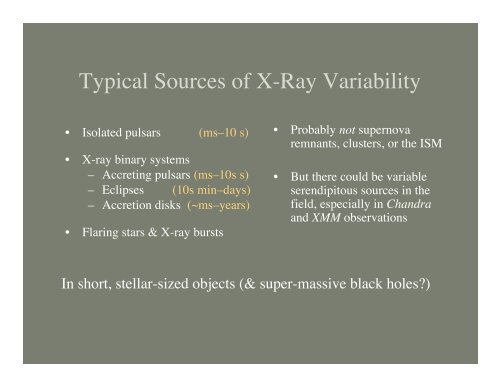The Why & How of X-Ray Timing - HEASARC - NASA
The Why & How of X-Ray Timing - HEASARC - NASA The Why & How of X-Ray Timing - HEASARC - NASA
Typical Sources of X-Ray Variability• Isolated pulsars (ms–10 s)• X-ray binary systems– Accreting pulsars (ms–10s s)– Eclipses (10s min–days)– Accretion disks (~ms–years)• Flaring stars & X-ray bursts• Probably not supernovaremnants, clusters, or the ISM• But there could be variableserendipitous sources in thefield, especially in Chandraand XMM observationsIn short, stellar-sized objects (& super-massive black holes?)
Why should I be interested?• Rotation of stellar bodies– pulsation period– stability of rotation• Accretion phenomena– broadband variability– “quasiperiodic” oscillations (QPOs)– bursts & “superbursts”• Binary orbits– orbital period– sizes of emission regionsand occulting objects– orbital evolution
- Page 1: The Why & How ofX-Ray TimingZ. Arzo
- Page 5 and 6: Sco X-1Accretion Science: QPOs from
- Page 7: BasicsA light curve (for each sourc
- Page 10 and 11: A quasiperiodicoscillation is a “
- Page 12 and 13: Estimating Variability from observa
- Page 14 and 15: Power Spectrum Statistics• Any fo
- Page 16 and 17: Tips• Pulsar (coherent pulsation)
- Page 18 and 19: SAX J1808: The First AccretingMilli
- Page 20 and 21: Step 3. Broadband feature(s) found?
- Page 22: Suggested Reading• van der Klis,
Typical Sources <strong>of</strong> X-<strong>Ray</strong> Variability• Isolated pulsars (ms–10 s)• X-ray binary systems– Accreting pulsars (ms–10s s)– Eclipses (10s min–days)– Accretion disks (~ms–years)• Flaring stars & X-ray bursts• Probably not supernovaremnants, clusters, or the ISM• But there could be variableserendipitous sources in thefield, especially in Chandraand XMM observationsIn short, stellar-sized objects (& super-massive black holes?)



